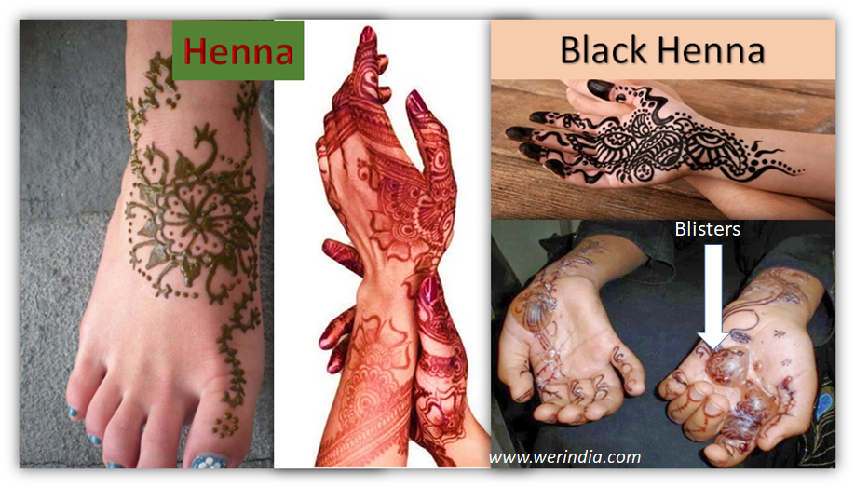
Black henna?! Henna is never black
Often you read the news or listen to someone telling how bad is temporary tattoo and how skin in hands and legs developed rashes and blisters because of application of henna or mehndi or “black henna”. Is henna bad for the skin? Before concluding without knowing the facts, one need to understand what exactly is the reason (for reaction) or is it a chemical that is responsible for this?
Traditional Henna is not black!
Many countries and religions are using a plant popularly known as “Henna” for traditional body art tattoo. These tattoos are temporary and women especially use this art to decorate/design hands and feet to celebrate auspicious occasion like wedding, engagements, festivals etc. Henna is a plant scientifically called “Lawsonia enermis”. It is also known by other names as mignonette tree and the Egyptian privet. Lawsone is the tannin compound produced by this amazing plant. Henna is popular in Asian countries. Traditional preparation for mehendi art starts by plucking the leaves of henna plant and grinding to make a paste of it with other ingredients like lemon juice, black tea, drops of Eucalyptus oil etc. Use of other ingredients varies from region to region.
Once mixed henna/mehendi will be kept for 24 hours to get desired reddish-brown color. And, artists with the help of fine tools (cone or small thin stick or thread) draw the body art. After drawing the design, it will be left to release the color for couple of hours. While waiting, lemon water with little sugar dissolved in it will be sprinkled on the design. This helps to release darker color and temporary henna tattoo remains longer than expected.
As you can tell the ingredients generally used in traditional henna is safe and one can use it without much doubts. IF the fresh leaves of henna is not available, one can use dry powder of leaves available in the market. While bringing it to home, one must read the ingredient label to make sure there is no artificial or synthetic chemicals added. If so, don’t buy it.
Addition of essential oils like eucalyptus or tree tea oil and the body heat can turn traditional henna to dark color giving black color look in the palm and hands. This color will turn to reddish brown in a day or two and looks beautiful. On the rest of the body, the stains will remain brown. It means, henna never leaves “black” stains on arms, legs and bellies!
What causes allergy? Henna, Indigo or Black henna
Decades ago, when there was no synthetic hair dye, people used to color the hair using henna and indigo color. Indigo color also extracted from plant. It is darker blue. While tattooing, Henna plant color was termed as Red Henna and Indigo was marketed as “Black Henna”. The name Indigo was given to hair and cloth dye. After dying hair with henna, applying indigo color to hair turns hair color to jet black. And it is safe.
Now in the market there is another product that is also sold as ‘black henna’ and it contains chemicals that can cause health issues.
Beware of black henna or kali mehendi
Also known as ‘peko”, black henna is the one consumers need to be aware off. It can cause blistering, open sores, scarring, and lifelong health problems. How and why these reactions happen? Reason for these horrible reactions is due to chemical reactions. Synthetic henna or black henna is made of chemicals. Let us see what exactly it is.
In many countries instead of traditional henna, artists use black henna that contains chemical Para-phenylendiamine, a black hair dye. It is the reason for blunders happening in the name of Henna and black henna. A temporary tattoo drawn using “Black Henna” is not safe as it can cause dangerous skin reaction.
Para-phenulendiamine is base for black hair dye that should not be put directly on skin or mixed with any material that touches skin. When we apply it on hair we should take precaution and use gloves. It should not touch scalp as it can cause serious injury. It is a strong sensitizer, transdermal toxin and considered to be a carcinogen. Many people get itching, blistering and hair loss from using black hair dye on their hair.
How to differentiate real henna, indigo and black henna?
If you look in the box, if the powder is green and has herbal dry leaf or hay odor then, it is probably powdered henna leaves or can be indigo color (not harmful). If the powder appears coffee colored or black then it could be para-phenylenediamine based hair dye.
To test, take little powder and mix with water.
- If the color of water turns to light green then it is henna. Powder might settle down at the bottom.
- If it turns blue then it is indigo color and it also does not stain skin black.
- If the color turns darker brown and back then it is because of PPD. It also gives strong chemical odor and turns skin black and gives reaction. This is hazardous and is a byproduct of coal tar!!
Next time when you visit a henna artist, before applying temporary tattoo, look at the ingredients of the tattoo powder. Ask the artists for details. If you feel it is unsafe and black henna then don’t apply. Traditional henna that is described above, is the best method as there are no complications develops when you apply on the skin.
References:
- http://www.hennaforhair.com/indigo/
- http://hennalounge.com/resources/black-henna/
Author: Sumana Rao | Posted on: October 17, 2017
« Selena Gomez’s kidney transplant due to Kidney Lupus Early signs of Alzheimer’s disease »






















Write a comment